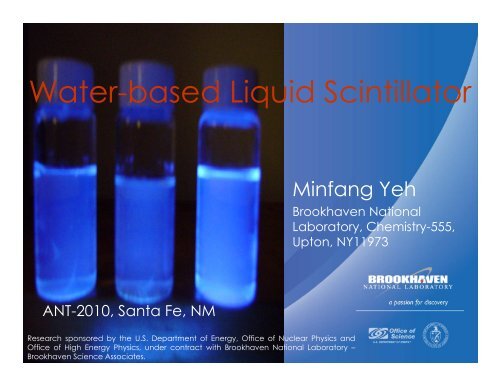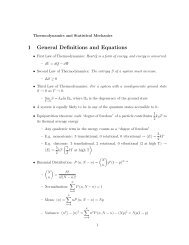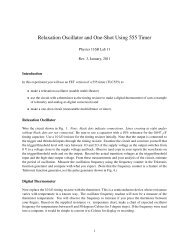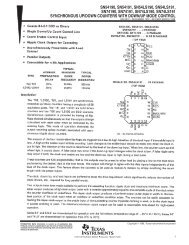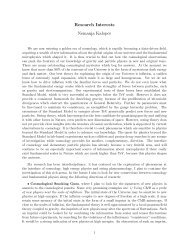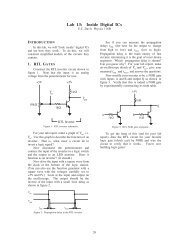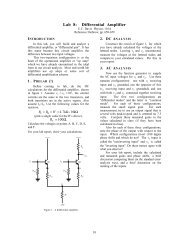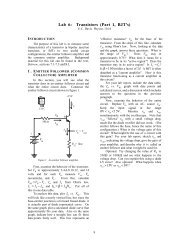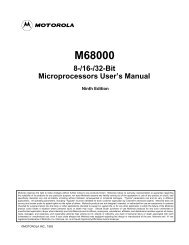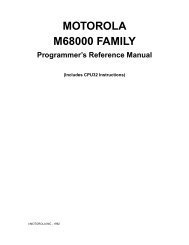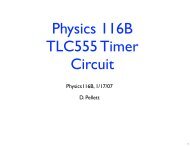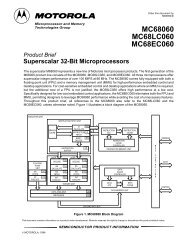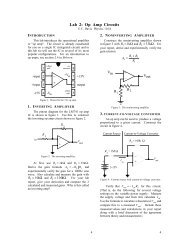Water-based Liquid Scintillator - Department of Physics
Water-based Liquid Scintillator - Department of Physics
Water-based Liquid Scintillator - Department of Physics
You also want an ePaper? Increase the reach of your titles
YUMPU automatically turns print PDFs into web optimized ePapers that Google loves.
<strong>Water</strong>-<strong>based</strong> <strong>Liquid</strong> <strong>Scintillator</strong><br />
Minfang Yeh<br />
Brookhaven National<br />
Laboratory, Chemistry-555,<br />
Upton, NY11973<br />
ANT-2010, Santa Fe, NM<br />
Research sponsored by the U.S. <strong>Department</strong> <strong>of</strong> Energy, Office <strong>of</strong> Nuclear <strong>Physics</strong> and<br />
Office <strong>of</strong> High Energy <strong>Physics</strong>, under contract with Brookhaven National Laboratory –<br />
Brookhaven Science Associates.
First anti-neutrino detector<br />
PET or CAT scan?<br />
http://www.strokecenter.org/patients/diagnosis/ct.htm
BNL 40+ years <strong>of</strong> neutrino at chemistry<br />
1961<br />
Radiochemical<br />
<strong>Water</strong><br />
<strong>Liquid</strong><br />
<strong>Scintillator</strong><br />
• HOMESTAKE Radiochemical Detector<br />
615 tons <strong>of</strong> C 2 Cl 4 ;<br />
37<br />
Cl + e 37 Ar + e - (~40 years)<br />
• GALLEX Radiochemical Detector<br />
30 tons <strong>of</strong> Ga; 71 Ga + e 71 Ge + e - (1986 - 1998)<br />
• SNO <strong>Water</strong> Čerenkov Detector (SNOLab)<br />
1-k tons <strong>of</strong> ultra-pure D 2 O (1996 - 2006)<br />
• LENS Real-time LS Detector (R&D)<br />
100 tons <strong>of</strong> ~8% 115 In in <strong>Liquid</strong> id <strong>Scintillator</strong> ill (began ~2000)<br />
• LBNE Long-Baseline Neutrino Experimen<br />
V beam to DUSEL (began~2002)<br />
• Daya Bay High-Precision Reactor 13 Detector<br />
200 tons <strong>of</strong> 0.1% Gd in <strong>Liquid</strong> <strong>Scintillator</strong> (began ~2003)<br />
• SNO+ Neutrino-less Double Beta Decay Real-time Detector<br />
1-k tons <strong>of</strong> 0.1% Nd in <strong>Liquid</strong> <strong>Scintillator</strong> (began ~2005)<br />
<br />
<br />
• <br />
<br />
<br />
2009 <br />
• Neutrino Application<br />
• Nonproliferation and/or Reactor Monitoring<br />
• Li/Zr/Ca-loaded <strong>Liquid</strong> <strong>Scintillator</strong> (began 2008)<br />
• <strong>Water</strong>-<strong>based</strong> <strong>Liquid</strong> <strong>Scintillator</strong><br />
3<br />
M. Yeh for ANT-2010
<strong>Liquid</strong> scintillators for large-scale physics<br />
• Expertise in low background counting, organic scintillators and, in particular<br />
metal loaded organic scintillators.<br />
• Interest for neutrino and neutron detectors.<br />
• Laboratory developed for the investigation <strong>of</strong> optical characteristics <strong>of</strong> a large variety <strong>of</strong> liquid<br />
scintillators:<br />
• PC, PCH, DIN, PXE, LAB<br />
• with high light yield, long attenuation length and low flammability<br />
• Absorption and emission spectra, extinction length, dependence on purity level,<br />
concentration <strong>of</strong> fluors and wavelength shifters, environmental factors (e.g. temperature,<br />
humidity, exposure to air)<br />
• Capability <strong>of</strong> purifying and synthesizing materials in-house and <strong>of</strong><br />
controlling the chemical processes.<br />
• Collaboration between <strong>Physics</strong> and Chemistry Depts. at BNL<br />
44<br />
M. Yeh for ANT‐2010
Metal loaded liquid scintillators<br />
Development and production <strong>of</strong> Metal-loaded loaded (Yb, In, Nd, Zr, Gd, Li, etc) liquid<br />
scintillator (LS) for neutrino experiments<br />
• LENS uses 125 tons <strong>of</strong> In-loaded LAB or PC beginning <strong>of</strong> M-LS in 2000<br />
• Daya-Bay uses 200 tons <strong>of</strong> Gd-loaded LAB<br />
• SNO+ uses 1 KT <strong>of</strong> Nd-loaded LAB<br />
• M. Yeh et al. Gadolinium-Loaded <strong>Liquid</strong> <strong>Scintillator</strong> for<br />
High-Precision Measurements <strong>of</strong> Antineutrino<br />
Oscillations and the Mixing Angle, θ13, NIM A 578<br />
(2007) 329-339<br />
Study <strong>of</strong> optical properties as a function <strong>of</strong> purity levels and <strong>of</strong> metal concentration<br />
Self-scavenging method to<br />
remove Th/U and improve UV<br />
carboxylic acids are the preferred choice<br />
5<br />
M. Yeh for ANT‐2010<br />
• M. Yeh et al. Purification i <strong>of</strong> lanthanides for large<br />
neutrino detectors, NIM A 618 (2010) 124–130
<strong>Liquid</strong> <strong>Scintillator</strong> for Particle Detector<br />
• High efficiency <strong>of</strong> converting kinetic<br />
energy <strong>of</strong> charged particle to detectable<br />
light<br />
• Good light transparency to the emission<br />
wavelength<br />
• Short decay time for fast signal pulse<br />
• Mass-producible<br />
• Index <strong>of</strong> refraction for scattering light<br />
• High flash point, low toxicity, safe to be<br />
used in confined space<br />
• Long stability and chemical compatibility<br />
6<br />
M. Yeh for ANT‐2010
<strong>Liquid</strong> Scintillation (versus <strong>Water</strong> Cherenkov)<br />
Cons<br />
Safety: Chemical hazard,<br />
Fire hazard, and Reactivity<br />
Cost:<br />
$2k/ton or $100M for 50 KT<br />
Handling & ES&H<br />
event reconstruction and<br />
PID<br />
Pros<br />
orders <strong>of</strong> magnitudes light<br />
output: smaller detector or<br />
less photo-sensors<br />
<strong>Physics</strong> <strong>of</strong> charged particles<br />
below Cherenkov threshold<br />
Excellent PSD to suppress<br />
background events<br />
Sub-MeV (geo-, solar- and<br />
reactor) neutrinos<br />
7<br />
M. Yeh for ANT‐2010
Comparisons <strong>of</strong> Selected <strong>Liquid</strong> <strong>Scintillator</strong>s<br />
first identified by SNO+<br />
8<br />
M. Yeh for ANT‐2010
NEPA assessment <strong>of</strong> fire safety for ongoing<br />
and newly yproposed p experiments<br />
Experiment<br />
LS<br />
Borexino PC ~3<br />
NEPA<br />
450<br />
Rating 400<br />
350<br />
Flashing<br />
Point<br />
Boiling<br />
Point<br />
9<br />
LENS LAB/PC 1/3<br />
Daya Bay LAB 1<br />
SNO+ LAB 1<br />
Reno LAB 1<br />
Double-<br />
CHOOZ<br />
KamLAND<br />
NOvA<br />
LENA<br />
20%PXE +<br />
80%dodecane<br />
20% PC +<br />
80%dodecane<br />
5% PC + 95%<br />
MO<br />
PXE/LAB/dodec<br />
ane<br />
Temperaturem m, C<br />
300<br />
250<br />
200<br />
2~1<br />
150<br />
3~2<br />
1~2<br />
1/1/2<br />
<strong>Liquid</strong> scintillators used in all ongoing g or proposed p experiments are<br />
combustible ; some are even close to flammable<br />
M. Yeh for ANT‐2010<br />
100<br />
50<br />
0<br />
PC PCH DIN PXE LAB MO Dodecane<br />
<strong>Scintillator</strong>
A large (>50kT) liquid scintillator has<br />
challenges <strong>of</strong><br />
• cost<br />
• attenuation<br />
• ES&H<br />
• Compatibility<br />
• etc<br />
IS THERE AN ALTERNATE?<br />
10
Light Yield <strong>of</strong> PC% in dodecane<br />
• By 137 Cs Compton<br />
scattering<br />
• Light-yield is a<br />
function <strong>of</strong><br />
percents <strong>of</strong> liquid<br />
scintillator; but is<br />
not linear<br />
11<br />
M. Yeh for ANT‐2010
<strong>Water</strong> Optical Transmission<br />
• Superior attenuation<br />
length <strong>of</strong> water<br />
could compensate<br />
the loss <strong>of</strong> photon<br />
• High proton density<br />
(6.69 69 atoms per c.c.)<br />
12<br />
M. Yeh for ANT‐2010
Goal <strong>of</strong> <strong>Water</strong> <strong>based</strong> liquid scintillator<br />
<strong>Water</strong>-<strong>based</strong> liquid scintillator is different from dissolving<br />
wavelength shifter in water.<br />
Develop a W-LS to be used as energy spectrometers in large-scale<br />
physics experiments<br />
• Replace the hundreds to many tons <strong>of</strong> unloaded or metalloaded<br />
organic liquid scintillators to provide:<br />
• simpler sensitive detection medium<br />
• fewer compatibility problems<br />
• cost savings<br />
• Non-linear photon production plus superior water attenuation<br />
length makes it possible to detect physics below Cherenkov<br />
threshold<br />
• PDK + channel becomes accessible<br />
13<br />
M. Yeh for ANT‐2010
Nucleon Decay<br />
The SUSY SU(5) model predicts<br />
the K-decay mode to be<br />
dominant with a partial<br />
lifetime varying from 10 29 y to<br />
10 35 yrs !<br />
( p k<br />
v)<br />
<br />
2.310<br />
33<br />
yrs<br />
SK<br />
H.Ejiri Phys. Re ev. C48 (1993) 14 442<br />
• 22.5 kT (7.5 x 10 33 protons & 6.0 x<br />
10 33 neutrons) at 40% coverage<br />
• T K+ ~340 MeV/c: below Cerenkov<br />
threshold<br />
•<br />
16<br />
O (p → 15 3/2 ) N* + 63 6.3 MeV<br />
14<br />
M. Yeh for ANT‐2010
<strong>Water</strong>-<strong>based</strong> LS for PDK +<br />
• A 50-kt detector would have a sensitivity <strong>of</strong> t >4×10 34<br />
yrs for PDK + model after 10 years <strong>of</strong> run time (LENA)<br />
• 150 p.e./MeV (30%)<br />
• 1/e ~20m<br />
• >4000m<br />
• 9000 photons/MeV for 100% LAB<br />
• 25% coverage gives 180 p.e. per MeV (DYB)<br />
• Assuming W-LS has 20% <strong>of</strong> S <strong>of</strong> LAB,<br />
• ~5 = exp(/20); 1/e >32m<br />
• Need to catch kaon before decay: t d
• Polarity Tension<br />
• Like to like<br />
CAN WE LOAD IT?
Surfactant reduces the tension; thus<br />
balances the “like to like”<br />
Conventional watermiscible<br />
cocktails for<br />
/ counting or in<br />
medical imaging are<br />
not stable in water<br />
A highly stable W-LS<br />
with long<br />
attenuation length<br />
that generates light<br />
as particle detector<br />
17<br />
M. Yeh for ANT‐2010
As much as 40% <strong>of</strong> liquid scintillator<br />
can be loaded d in water<br />
18<br />
M. Yeh for ANT‐2010
• P urification <strong>of</strong> raw mat erials before<br />
production<br />
• Online- purification during the data-<br />
taking period<br />
LONG ATTENUATION LENGTH<br />
IS THE KEY<br />
M. Yeh for ANT‐ 19<br />
2010
Purification Scheme and Strategy<br />
• dry-column extraction<br />
ti<br />
• freezing-isolation<br />
• Short-path vacuum distillation<br />
• Aqueous/organic solvent-washing<br />
• Re-crystallization/dissolution<br />
• contractors<br />
20<br />
M. Yeh for ANT‐2010
0.5% W-LS achieved excellent optical<br />
transmission<br />
i<br />
after a rather complicated<br />
purification scheme<br />
21<br />
M. Yeh for ANT‐2010
Online purification is achievable; but<br />
not easy<br />
22<br />
M. Yeh for ANT‐2010
Characterization <strong>of</strong> W-LS by GC-MS<br />
23<br />
M. Yeh for ANT‐2010
• -ray Compton Scattering<br />
• Emission fluorescence spectroscopy<br />
IS THERE A LIGHT?<br />
M. Yeh for ANT‐ 24<br />
2010
~7% W-LS has a light-yield <strong>of</strong> 15~20%<br />
<strong>of</strong> pure LAB (by 137 Cs)<br />
UV<br />
—W‐LS —<br />
LAB<br />
25<br />
M. Yeh for ANT‐2010
Emissions <strong>of</strong> W-LS and pure LS<br />
• s <strong>of</strong> 10% W-LS is<br />
~25% <strong>of</strong> pure LAB<br />
• Non-radiative<br />
energy-transfer<br />
mechanism is<br />
not wellunderstood<br />
yet<br />
26<br />
M. Yeh for ANT‐2010
SNO went through h a search <strong>of</strong> water-soluble<br />
wavelength shifters and identified few<br />
promising candidates (for Cerenkov)<br />
27<br />
M. Yeh for ANT-2010
• Time-resolved fluorescence<br />
spectroscopy<br />
• Single-photon counting?<br />
HOW FAST IS THE LIGHT?
decay time is in the region <strong>of</strong> interest<br />
29<br />
M. Yeh for ANT‐2010
• Attenuation measurement <strong>of</strong> light<br />
change at 1% precision<br />
• Use for Daya Bay, SNO+ and LENS<br />
BNL 2-M DUAL-BEAM SYSTEM
Purification is essential for optical transmission,<br />
particularly for large LS detector<br />
Close to the baseline<br />
that a long path-<br />
length system is<br />
needed!<br />
31<br />
M. Yeh for ANT‐2010
BNL 2-m system<br />
- at 1% precision<br />
-2 s per measurement<br />
32<br />
M. Yeh for ANT‐2010
0.1% Nd-LAB by UV 10-cm and 2-m system<br />
2.42m<br />
3.75m<br />
3.31m<br />
5.26m<br />
6.23m<br />
Chris 33 Ouellet M. et Yeh al. for in preparation ANT‐2010 for NIM‐A
Double-baselinedbaselined<br />
10-cm UV agrees<br />
with 2-m<br />
measurement very<br />
well!<br />
Johnny Goett et al. in preparation for<br />
NIM‐A<br />
34<br />
M. Yeh for ANT‐2010
Summary<br />
• W-LS could be a promising detection medium<br />
for large detector<br />
• Samples <strong>of</strong> W-LS have been stable (1-yr+) since<br />
preparation<br />
• Plenty <strong>of</strong> light; but need to optimize fluor selection<br />
(organic or aqueous)<br />
• The decay time is fast<br />
• Online purification is the key; but can we run it at<br />
lower temperature to minimize the<br />
microorganisms?<br />
i • <strong>Physics</strong> <strong>of</strong> PDK + and sub-MeV neutrinos<br />
35<br />
M. Yeh for ANT‐2010
Future Plan<br />
• Light production property, quenching effect<br />
as a function <strong>of</strong> dE/dx, in response to a proton<br />
beam at NSRL (BNL) with kinetic energy <strong>of</strong> 100<br />
to 1000 MeV.<br />
• A 250-L prototype for Cf-252 neutron capture.<br />
• Can we preserve the scintillation and<br />
Cerenkov radiations simultaneously?<br />
• Little scintillation not to overcome Cerenkov (5<br />
p.e./MeV at 30%)<br />
• Neutron-tagging g by adding metal (such as<br />
Gd) into the W-LS?<br />
• IBD followed by Gd-capture sum <strong>of</strong> 8-MeV<br />
36<br />
M. Yeh for ANT-2010
Neutrino at BNL-Chemistry<br />
• Richard Hahn<br />
• James Cumming (retiree)<br />
Postdoctoral<br />
Students/Technicians<br />
• Sunej Hans<br />
• Richard Rosero<br />
• Liangming Hu • Wanda Beriguete<br />
• Pankaj Sinha • Wai Ting Chan<br />
• 1~2 openings • John Goett (LNGS)<br />
Research sponsored by the US U.S. <strong>Department</strong> <strong>of</strong> Energy, Office <strong>of</strong> Nuclear <strong>Physics</strong> and Office <strong>of</strong> High<br />
Energy <strong>Physics</strong>, under contract with Brookhaven National Laboratory – Brookhaven Science Associates.<br />
37 M. Yeh for ANT‐2010


